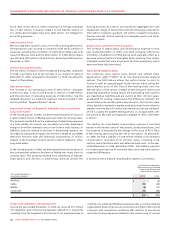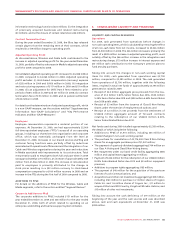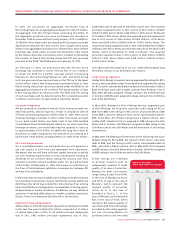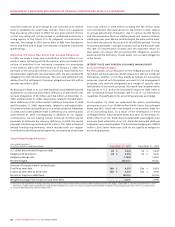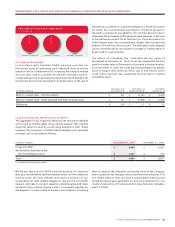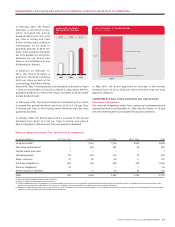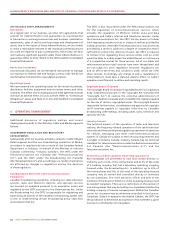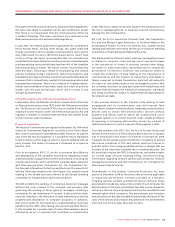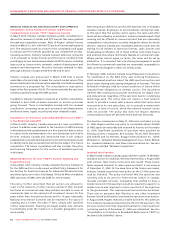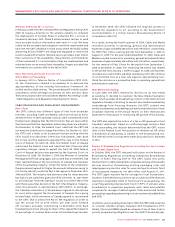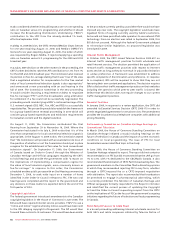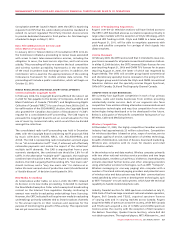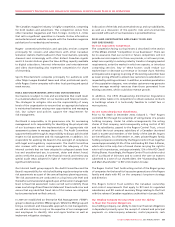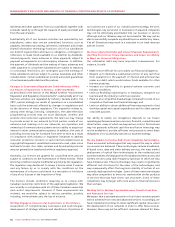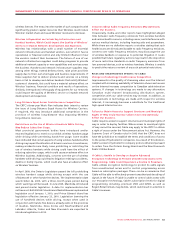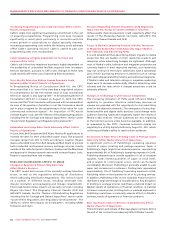Rogers 2009 Annual Report Download - page 50
Download and view the complete annual report
Please find page 50 of the 2009 Rogers annual report below. You can navigate through the pages in the report by either clicking on the pages listed below, or by using the keyword search tool below to find specific information within the annual report.
54 ROGERS COMMUNICATIONS INC. 2009 ANNUAL REPORT
MANAGEMENT’S DISCUSSION AND ANALYSIS OF FINANCIAL CONDITION AND RESULTS OF OPERATIONS
WIRELESS REGULATION AND REGUL ATORY DEVELOPMENTS
Consultation on the Renewal of Cellular and Personal
Communications Services (“PCS”) Spectrum Licences
In March 2009, Industry Canada initiated a public consultation to
discuss the renewal of cellular and PCS licences that were granted
through any competitive process. Most of Rogers’ cellular licences
expire on March 31, 2011 with the PCS auction licences expiring June
2011. The decisions made as a result of this consultation will apply
to cellular and PCS licences granted by any competitive process,
including auctions. Industry Canada received extensive comments
on its proposal to renew licences and the licence conditions that
would apply to new and renewed cellular and PCS licences, including
issues such as licence terms, renewals, extent of deployment and
research and development. No policy has been released to date,
although a decision is expected before the end of 2010.
Industry Canada also announced in March 2009 that it would
undertake a formal study to assess the current market value of the
above noted spectrum licences with a separate consultation seeking
comments on a proposed fee. This consultation is expected to
begin in the first quarter of 2010. This review excludes the spectrum
recently acquired through the AWS auction.
In addition, Industry Canada in response to a further consultation
initiated in April 2009 received comments on auction processes
going forward. There is considerable overlap with the renewal
consultation concerning issues such as research and development
and licence terms. Again, no policy has been released to date.
Consultation on Transition to Broadband Radio Service (“BRS”)
in the Band 2500-2696 MHz
In March 2009, Industry Canada announced a new consultation
process to address issues related to the transition to BRS licencing
in this band and the establishment of a firm transition date to allow
for nation-wide implementation of a new band plan and mobile
services. Industry Canada also announced that it will conduct
a stakeholder proposal development process with existing licencees
to identify band plan proposals that will be the subject of a future
consultation. The future consultation will also consider the policy
and licencing frameworks for the auction of available spectrum
in this band.
Advanced Wireless Services (“AWS”) Auction, Roaming and
Tower/Site Policy
In November 2007, Industry Canada released its policy framework
for the AWS auction in a document entitled Policy Framework for
the Auction for Spectrum Licences for Advanced Wireless Services
and other Spectrum in the 2 GHz Range. Of the 90 MHz of available
AWS spectrum, 40 MHz were set aside for new entrants.
The policy further prescribed that all carriers are allowed to
roam on the networks of other carriers outside of their licenced
territories at commercial rates. New entrants are able to roam at
commercial rates on the networks of incumbent carriers for five
years within their licenced territories and for 10 years nationally.
National new entrant licencees will be entitled to five years of
roaming and a further five years if they comply with specified
rollout requirements. Roaming privileges enable new entrants
to potentially enter the market on a broader geographic scale
more quickly.
New entrants are defined as carriers with less than 10% of Canada’s
wireless revenue. Roaming is to be provided at commercial rates.
In the event that the parties cannot agree, the rates and other
terms will be settled by an arbitrator. Industry Canada expects that
roaming will be offered at commercial rates that are reasonably
comparable to rates that are currently charged to others for similar
services. Industry Canada also mandated antenna tower and site
sharing for all holders of spectrum licences, radio licences and
broadcasting certificates. All of these entities must share towers
and antenna sites where technically feasible at commercial rates.
Where parties cannot agree on terms, the terms will be set by
arbitration. It is expected that site-sharing arrangements would
be offered at commercial rates that are reasonably comparable to
rates currently charged to others for similar access.
In February 2008, Industry Canada issued Responses to Questions
for Clarification on the AWS Policy and Licencing Frameworks,
which answered questions about the AWS spectrum auction and
about tower sharing and roaming obligations of licencees. This was
followed in February 2008 by revised conditions of licence which
imposed those obligations on wireless carriers. The documents
clarified that roaming must provide connectivity for digital voice
and data services regardless of the spectrum band or underlying
technology used. The policy does not require a host network
carrier to provide a roamer with a service which that carrier does
not provide to its own subscribers, nor to provide a roamer with
a service, or level of service, which the roamer’s network carrier
does not provide. The policy also does not require seamless
communications hand-off between home and host networks.
The Auction commenced on May 27, 2008 and concluded on July
21, 2008. Rogers was the only party to successfully obtain 20 MHz
of AWS spectrum nationally and received its licences on December
22, 2008. Significant quantities of spectrum were acquired by
existing wireless companies, Bell Canada, TELUS, MTS Allstream
and SaskTel and by entrants, Bragg Communications Inc., DAVE
Wireless Inc., Globalive Wireless Management Corp., Public Mobile
Inc., Quebecor Media Inc. and Shaw Communications Inc. See also
the section entitled “Wireless Competition”.
Inukshuk Joint Venture
In March 2006, Industry Canada approved the transfer of Wireless’
Inukshuk licence to Inukshuk Wireless Partnership, a Rogers-Bell
joint venture. New licence terms were also issued. These licence
terms required Inukshuk to return spectrum that it is not using as
of December 31, 2009. At the same time as the licence was issued,
Industry Canada issued their new policy on the 2.5 GHz spectrum
used by Inukshuk. The policy confirmed that the spectrum was
currently only to be used for fixed services (which, in Canada,
includes portable services). Companies that wished to have a
mobile licence for this spectrum would be required to apply for a
mobile licence and required to return one-third of the spectrum
to the government. The returned spectrum would be auctioned.
There was no assurance that Wireless or any other incumbent
licencee would be allowed to purchase the spectrum at an auction.
In August 2009, Rogers received a mobile licence for this spectrum
from Industry Canada and returned one-third of the spectrum. The
previous licence term that required Inukshuk to return spectrum
not being used as of December 31, 2009 was eliminated. See also
“Consultation on Transition to Broadband Radio Service (“BRS”) in
the Band 2500-2696 MHz” above.


